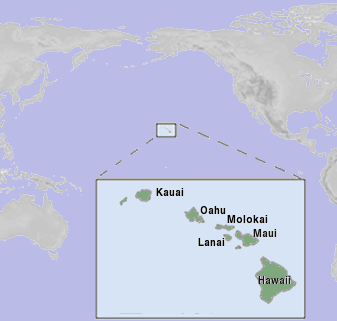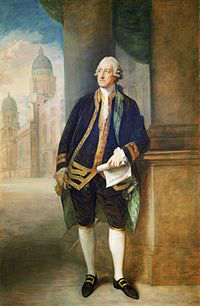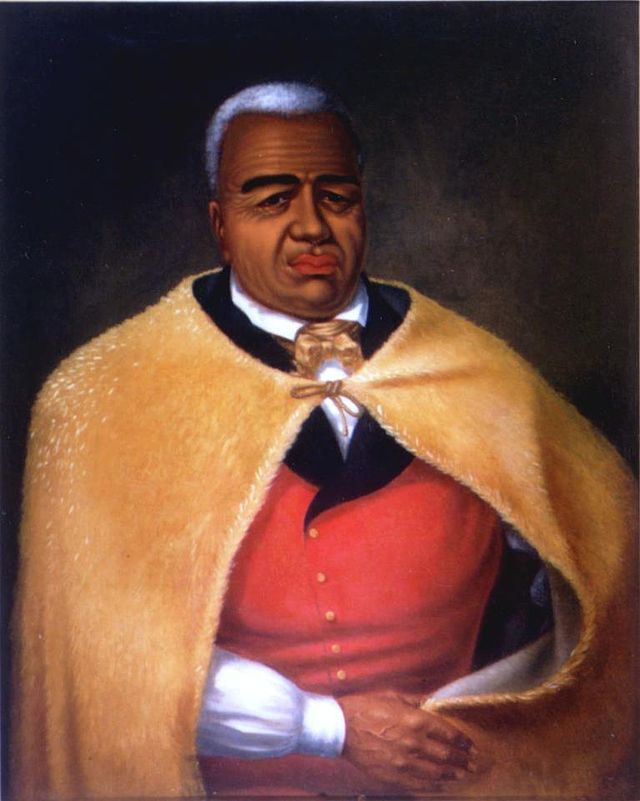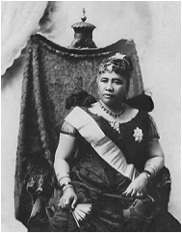HAWAII
Dreams come true in Blue Hawaii…
—Bing Crosby, Blue Hawaii
A tourist in Hawaii stops a man on the beach.
Tourist: “Sir, could you settle a dispute for my wife and me?”
Man: “Of course.”
Tourist: “Is the name of this island pronounced ‘Ha Waii’ or ‘Ha Vaii’?”
Man: “It is pronounced ‘Ha Vaii’.”
Tourist: “Thank you.”
Man: “You’re Velcome.”
—Old Joke
“Book him, Danno.”
—Jack Lord as Steve McGarrett in Hawaii 5-O
Island Paradise
On December 7, 1941, a date which has, as predicted, lived in infamy, Hawaii was not a state. It was a U.S. possession with territory status—much like the U.S. Virgin Islands or Guam today—which contained an excellent harbor that the U.S. had acquired while the islands were still a sovereign kingdom. In the American lexicon, “Pearl Harbor” is not so much a place as an event. For most of us the story of Pearl Harbor begins on the morning of December 7, as if the harbor and the naval base magically appeared on the planet on that date, just in time to be destroyed by Japanese fighter planes.

Morbidly ironic for the purposes of this book is that the Navy named its battleships (the primary targets of the Japanese on that day) after U.S. states, and so most of the ships damaged or destroyed that day had state names: The U.S.S. West Virginia, U.S.S. Arizona, U.S.S. Tennessee, etc. The attack on Pearl Harbor was, of course, monumental in American history; it is one of those rare events that, thanks in part to blockbuster motion pictures, even the most historically-challenged of Americans is acquainted with. But the history of the islands themselves remains somewhat obscure.
Of course, when we think of Hawaii it is not usually in the context of something as academic as the study of history. What comes to mind first is paradise—warm beaches with gentle breezes, leis and hula dances, exotic vacations in a tropical haven, and totally awesome surfing. But Hawaii is actually rich in native culture. Its isolated location and unique cultural demographic allow travelers to feel as if they’ve escaped to a far-away land, and with a 1,625 mile distance between the islands and the U.S. mainland, they have. It is unfortunate that the state most associated with pleasure and beauty was also the site of one of the most tragic events in our nation’s history.
A Place of Origin
Hawaii is the northernmost archipelago of the Polynesian islands, which include New Zealand and Easter Island. Researchers continue to debate theories about how exactly the islands became populated, but there is consensus on some points. It is generally agreed that hundreds of years before James Cook found Hawaii—a dominant theory suggests around 350-400 CE—Polynesian sailors from other islands, probably the Marquesas, discovered and settled the islands and formed their own society. It is not clear whether they came intentionally or accidentally or how many people constituted the original settlement, but archaeological as well as language and cultural studies link Hawaii’s earliest residents to other Polynesian societies.
The name Hawai’i was the word the natives used to identify their home island to early European explorers. The apostrophe represents a glottal stop, a sound made by cutting, and then resuming, the sound of the vowel, as in “uh-oh.” This diacritic, called an ‘okina in the Hawaiian language, has historically been somewhat ignored by English writers and speakers, presumably because of the absence of such a marking or speech pattern in our own language. But its absence produces Hawaii, which contains the phonetically awkward double i, so the ‘okina never completely disappeared from the Anglicized version of the word. The “w” in the native language can produce either a “w” or “v” sound when following an “a” making either “Hawai’i” or “Havai’i” a correct pronunciation.
The word “Hawai’i” is believed to be related to “Hawaiki,” which is used by natives of New Zealand, the Maori (who share cultural as well as linguistic similarities with Hawaiians), to describe their place of origin, though not necessarily a literal place. The word may mean a specific place or simply the concept of origin.1 Another theory, based on Hawaiian tradition, holds that the word “Hawaiiloa” was the name of the fisherman who first discovered the islands.
The Hawaiian people had names for all of the islands in the chain, but there was no central government for all of them before contact with Europeans—only feudal societies with local chiefs who periodically warred with each other to gain territory and power. The origins of the names for the islands is not clear, but a common theory is that most, like Maui and Oahu, were named for gods or demi-gods by their earliest inhabitants.
An alternate spelling of the state’s name, “Owhyhee,” was used in the journals of early explorers and survived for decades as a popular method for representing the word. A county in southern Idaho uses this spelling, having been named in honor of three Hawaiian fur trappers who were lost in that region in 1819 while trapping game along a section of the Snake River.
Sandwich
The Hawaiian Islands first came onto the international scene during the American Revolution. British Captain James Cook was sailing to the western coast of North America, looking for a water route across the continent, when he stumbled upon the tiny island chain. He went ashore on the big island on January 21st, 1778, and was greeted with the curious admiration of some of the island chiefs. Cook was impressed with the beauty of the place, and in his journal several days later he named the islands for his benefactor, Sir Edward Montagu, the Fourth Earl of Sandwich, who presided over the Board of Admiralty back in London and had been instrumental in assigning this voyage to Cook. Cook wrote:
Of what number this newly-discovered Archipelago consists, must be left for future investigation. We saw five of them, whose names, as given by the natives, are Woahoo [Oahu], Atooi [Kauai], Oneeheow [Niihau], Oreehoua [Lehua], and Tahoora [Kaula]...I named the whole group the Sandwich Islands , in honor of the Earl of Sandwich.2
At the same time that John Montagu, the fourth Earl of Sandwich, was lending his name to these new-found Polynesian islands, he was also lending it to a new food, or rather, a new way of eating his preferred food—salt beef between two slices of bread. The story goes that Montagu was an insatiable gambler who would frequently sit at a gaming table for many hours at a time. So as not to interrupt a run of luck, he began asking for his food to be served between slices of bread so that he could hold his meal in one hand, his cards in the other. Others who gambled with him, presumably just as dedicated to their vice and just as hungry, began asking for the “same as Sandwich,” and thus the name of the new culinary contrivance emerged, and the “sandwich” became wildly popular.

4th Earl of Sandwich, 1783
In fact, while the name “Sandwich” as applied to the islands (which admittedly conjures up strange images of sandwiches hanging from palm trees or islands between two slices of bread) would fade in time to be replaced with an indigenous title, the name of the food has become ubiquitous, especially in the U.S. Quiznos®, Schlotzky’s®, and Subway® can all thank John Montagu for his invention, as can school children worldwide who now have a place to put their peanut butter and jelly.
Cook
Cook and his crew (which, incidentally, included George Vancouver, who would eventually lend his name to Vancouver Island in Canada, as well as William Bligh, who would in later years captain the ship Bounty and survive one of the most famous mutinies in naval history) left the islands after only a few days in order to complete their mission. They sailed up the Pacific Coast all the way to Alaska and satisfied themselves that the Northwest Passage did not exist. Then they headed back to the Sandwich Islands.

A year after they first set eyes on the islands, the crews of Cook’s two ships, the Discovery and the Resolution , studied the shores of the Big Island of Hawaii for several weeks before finally weighing anchor at Kealakekua Bay on January 17, 1779. They took advantage of their time there, loading up with provisions, engaging in trade with the Hawaiian men, and fraternizing with the women. Among those natives who came aboard to trade was Kamehameha, the nephew of a local chief. Kamehameha would eventually use the metal tools and weapons that he acquired by trading with the Europeans to achieve power over all of the islands.

Hawaiian Islands
The British sailors set sail for home in February of 1779 but were quickly turned back after an intense storm caused severe damage to one of the ships. But for that storm, Cook might have lived to reap the rewards that his discovery warranted but instead he was doomed to die in the place he had dubbed “the Sandwich Islands.” The natives, who had earlier deified the British explorer as a god of the harvest, resented being enslaved in the repair of Cook’s ship. (Imagine!) This caused increasing tensions, which were exacerbated by the theft by Hawaiians of one of Cook’s smaller boats. Cook went ashore to try to gain the return of the stolen craft by kidnapping a local chief and holding him hostage, but his tactic backfired, and he was stabbed to death in a confused, bloody clash with the island natives.3 Cook’s crew limped home, the discovery of this beautiful new land now bittersweet.
After Cook
After word of Cook’s discovery spread, the Sandwich Islands began to appear on maps in Europe and around the world. Meanwhile, on the islands, Kamehameha used the weapons and boat obtained from the white explorers to expand his reign, conquering virtually the entire chain of islands. He was now recognized as King of Hawai'i to the island population and King of the Sandwich Islands to international observers.
Most historians portray Kamehameha as a wise and pragmatic ruler who guided his people into the perilous new world of American and European domination. Others maintain he was somewhat greedy and had a weakness for the luxuries with which he was bribed by white traders. What is certain is that during his rule, with increasing exposure to the rest of the world via merchant ships, the Hawaiian population began to decline dramatically. Rampant infections—including venereal disease and a devastating cholera epidemic in 1804—as well as the oppressive sandalwood trade which effectively enslaved thousands of natives, were among the causes of death for over 100,000 Hawaiians by the time of the king’s own death in 1819.
Almost immediately after Cook found them, American interest in the Sandwich Islands was strong. While French, British, Portuguese, and other nations pursued a relationship with the islands, it was American businessmen to whom Kamehameha granted the sandalwood monopoly, and it was Americans who came as protestant missionaries in 1820 to evangelize and “civilize” the natives of Hawaii. The influence that these businessmen and missionaries wielded among the monarchs of the Hawaiian Kingdom can hardly be overstated, but their motives, in many cases, were suspect. White men familiar with international commerce wanted to monopolize, and eventually to own, the natural resources of this tropical paradise, and they clashed constantly with the few white Americans and Europeans who had the real interests of the Hawaiian people at heart. For a hundred years, from the time of Kamehameha I until the downfall of the monarchy in the 1890s, white men with varying motives served as royal ministers and advisers, and in 1840 they were instrumental in the passage of the first Hawaiian Constitution.
During those political power struggles, Hawaii had something of a dual identity. While the name “Sandwich Islands” had been widely used by those outside the islands, it never caught on within the kingdom, where “Hawai’i” or “Hawaiian Islands” was much more common. According to an article by Russell Clement in the Hawaiian Journal of History , it was the 1840 constitution that marked the beginning of the end for the name “Sandwich Islands”:
Officially, then, the 1840 constitution named the islands the Hawaiian Islands . The 1842 constitution reinforced the name and later laws and constitutions consistently follow the 1840 precedent. After 1840, the name Sandwich Islands was slowly replaced by the name Hawaiian Islands .4
Americans
In 1876 the U.S. signed a reciprocity agreement with King David Kalakaua of the Hawaiian Islands. With this treaty heavy tariffs were removed from imported Hawaiian sugar produced on Hawaiian plantations. In return, the United States received an excellent still-water harbor on the island of Oahu, which the Hawaiians called Pearl Harbor. Now the land owners in Hawaii, largely naturalized Americans, were more powerful than ever, and cries for annexation to the U.S. became loud and frequent. In 1887 King Kalakaua was forced, under threat of an armed uprising, to sign what is historically called the “Bayonet Constitution” which deprived him, and thus the native Hawaiian people, of much of their political power.5
The last Hawaiian monarch, Queen Lili’uokalani, Kalakaua’s sister, attempted to curtail some of the power of the American landowners, only to find herself surrounded by intimidated cabinet ministers and an illegally deployed U.S. military. She was forced to yield her authority to the Americans in a relatively bloodless revolution in 1893. A provisional government was established with Sanford B. Dole (yes, the Dole of pineapple fame) as president, and soon the process of annexation by the United States was officially underway. It was temporarily stalled when President Grover Cleveland discovered the coercion, backed by U.S. naval forces, which had forced the Queen’s abdication, but the power wielded by annexationists both inside and outside of Hawaii was strong, and Cleveland was unable to assist the queen in regaining her throne.

In 1894 Sanford Dole established the “Republic of Hawaii” and declared himself president. The following year a futile attempt to take back the kingdom for the Hawaiian monarchy ended in violence and bloodshed, and Queen Lili’uokalani was arrested for treason and imprisoned at Iolani Palace in Honolulu for nine months.
In 1898, in a flurry of imperialism, the new president of the United States, William McKinley, and the expansionist Congress annexed Hawaii—as well as Puerto Rico, Cuba and the Philippines. Hawaii was named an official U.S. Territory, and Sanford Dole was appointed governor.
Statehood
“Mr. Vice President,” announced President Franklin D. Roosevelt on December 8, 1941. He continued solemnly, “Mr. Speaker, members of the Senate and the House of Representatives: yesterday, December 7th, 1941—a date which will live in infamy—the United States of America was suddenly and deliberately attacked by naval and air forces of the Empire of Japan.”
The speech was prescient and inspired. The date has, in fact, lived on in infamy. Several generations after the attack, December 7th is still observed as Pearl Harbor Day, though decades after our nation’s vilification of Japan, relations with that country have been normalized and become even congenial and respectful.
At the risk of nitpicking, however, it wasn’t technically the United States of America that was attacked by the Empire of Japan. Certainly it was our military forces, our naval base, and our territorial holdings that were devastated by those Japanese bombs and bullets. But that naval base wasn’t in the United States at the time of the attack. Pearl Harbor was in Hawaii, and Hawaii wasn’t a state. It was a U.S. territory that had been struggling for statehood for over forty years. That struggle would continue for another seventeen years after the attack on Pearl Harbor, and it would be filled with ironies.
Among the most vocal proponents for statehood within the islands were Hawaii’s Asian citizens6 who wanted more local control over their government. The Asian population was quite large, much larger than the white population, and was composed mostly of Japanese who had been (or were descended from those who had been) imported as labor for the sugar plantations in the 1800s.
Opposing statehood were the very whites who had affected annexation in the first place. Under territory rule these plantation owners, much like the railroad owners on the mainland, received political perks and spoils from appointed governors and judges. After statehood those officials would be elected by the people of Hawaii, and the powerful white land owners would no doubt lose the favoritism they enjoyed. Ironically, joining the plantation owners against statehood were an active segment of the native population who wished, more and more futilely, for a return to sovereignty. There is to this day a vocal outcry by some native Hawaiians protesting the forced colonization and annexation of the islands by the U.S.
In Congress, biases against statehood hinged primarily on the unwillingness to add such a largely non-Caucasian population to the union. Before and during World War II, this bias was specifically directed at the Japanese Hawaiians whose loyalties were questioned. This racial bias was especially strong following the bombing of Pearl Harbor, after which martial law was imposed upon the islands for three years. Shortly after the war, the concern was directed more toward the growing Communist party in the islands, who were striving hard for fair labor practices for the plantation workers.
After years of machinations by powerful business, political, and military interests, Hawaii was inducted as the 50th state in the union. Dwight D. Eisenhower signed the admission bill on August 21, 1959, a date that is commemorated within the islands with a state holiday every third Friday in August.
End Notes
1. “Origins of Hawaii’s Names,” Hawaii School reports , http://www.hawaiischoolreports.com/symbols/origins.htm, 12/16/03.
2. Clement, Russell, “From Cook to the 1840 Constitution: The Name Change from Sandwich to Hawaiian Islands,” The Hawaiian Journal of History , vol. 14, 1980, p. 50.
3. Dougherty, Michael, To Steal a Kingdom: Probing Hawaiian History (Island Style Press, Waimanalo, 1992) p. 29-41
4. Clement, p. 53.
5. Dougherty, pp. 161-162.
6. Smyser, A. A., “Campaigners for Hawaii’s Statehood,” Honolulu Star Bulletin , March 11, 1999, http://starbulletin.com/1999/03/11/editorial/smyser.html, 7/12/03.